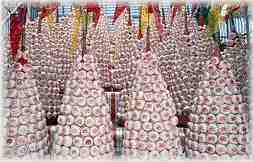~ April ~

Cheung
Chau Bun Festival
There is only one Bun Festival in all the world and only takes place once a year on the Cheung Chau Island in Hong Kong. It also known as the Festival of the Bun Hills. The central features are three huge conical bamboo and paper towers about sixty feet tall. Each tower studded with pink and white buns and each bun is a part of the grand offering to the ghosts. It is a symbol of good fortune and a talisman against sickness for whoever obtain it. The celebration lasts eight days, during which there are religious observances, processions and Chinese opera. All held in a fiesta-like atmosphere that sweeps the entire island. The climax of the Bun Festival is a large procession on the fourth day. People dressed in colourful costumes, participants march, walk on stilts or ride on floats through the winding streets of the village. Children can be seen "floating" in the air, here and there, dressed as characters from Chinese mythology. They are supported by wires attached to harnesses under their clothing. The distribution of the buns at midnight on the last night is the climax towards which everything moves. At midnight, after the ghosts have had their fill of the spiritual essence of the buns, the crowds is invited to scramble for the material remains. They stripped buns as fast as they can. In about 3 minutes, there is nothing left but scaffolding and torn paper. The festival is over for another year! Since 1977, the towers collapsed under the assault, the scamble has been officially forbidden. Nowadays, they buns are distributed by hand the next morning.
Birthday
of the Lord Buddha
The founder of Buddhism, Prince Siddhartha Sakyamuni, was born in a small state in the kingdom of Nepal. His father, the king, kept him at home and surrounded him with luxury, trying to prevent him from seeing any sad or ugly sights. But, he was in vain. The boy saw the pain of extreme old age; he encountered a man who was seriously ill; he saw a funeral etc. One day, the Prince met a poor monk begging for food. Despite the monk's poverty, he had a look of great happiness. The Prine talked to the monk for a long time and that night he left the palace secretly and began the life of a monk, to seek the truth. After six years' experience in most severe privations, he was declaring that he would not rise till he had found the answer to the riddle of suffering. Sakyamuni was tempted by Mara, the Spirit of Evil, sent demons to try to terrify him and then his own daughters to seduce him. Then, Mara admitted defeat and, while the hosts of Heaven rejoiced, Gautama received the Ultimate Peace of True Knowledge. He spent the rest of his life in preaching this Truth to others. His message was simple to understand but difficult to follow : all human misery is caused by the fact that people are too much attached to the world. What one have to do, is renounce all desire. Detach yourself from all the manifestations of selfhood and you will attain peace. Buddhism is based on the monastic life. Also, there are groups of laymen and women following the Buddha's precepts in the world and perhaps go into retreat from time to time. Buddhish temples hold ceremonies on Buddha's birthday and on the anniversaries of his enlightenment.
Birthday
of T’am Kung
T'am Kung, another of the deities, who appeals mainly to those people live and work on boats. He specializes in weather control. By throwing up a handful of pease, he can calm the most violent storm; by substituting a cup of water for the peas, he can cause a downpour heavy enough to put out a fire. He has a staunch following among the lightermen of the harbour whose livelihood depends mainly upon the weather and for whom a fire on board can spell disaster. T'am Kung can slo heal the sick by influencing their subconscious minds. His festival is one of the most spectacular celebrations.
|
|
|
|
|
|
|
|
|
|
|
|
|
|
|
|